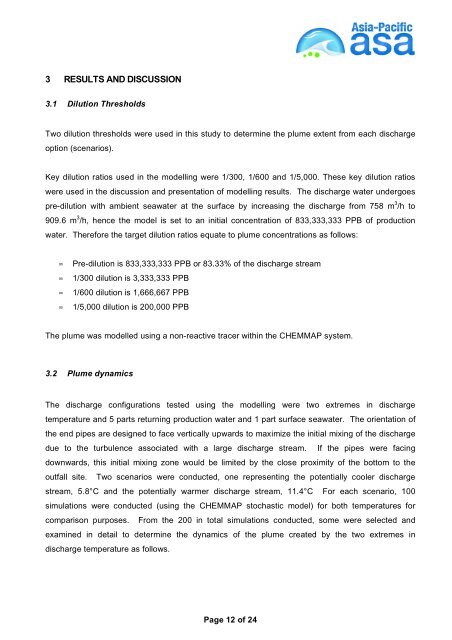Appendices 5-13 - Nautilus Cares - Nautilus Minerals
Appendices 5-13 - Nautilus Cares - Nautilus Minerals
Appendices 5-13 - Nautilus Cares - Nautilus Minerals
Create successful ePaper yourself
Turn your PDF publications into a flip-book with our unique Google optimized e-Paper software.
3 RESULTS AND DISCUSSION<br />
3.1 Dilution Thresholds<br />
Two dilution thresholds were used in this study to determine the plume extent from each discharge<br />
option (scenarios).<br />
Key dilution ratios used in the modelling were 1/300, 1/600 and 1/5,000. These key dilution ratios<br />
were used in the discussion and presentation of modelling results. The discharge water undergoes<br />
pre-dilution with ambient seawater at the surface by increasing the discharge from 758 m 3 /h to<br />
909.6 m 3 /h, hence the model is set to an initial concentration of 833,333,333 PPB of production<br />
water. Therefore the target dilution ratios equate to plume concentrations as follows:<br />
• Pre-dilution is 833,333,333 PPB or 83.33% of the discharge stream<br />
• 1/300 dilution is 3,333,333 PPB<br />
• 1/600 dilution is 1,666,667 PPB<br />
• 1/5,000 dilution is 200,000 PPB<br />
The plume was modelled using a non-reactive tracer within the CHEMMAP system.<br />
3.2 Plume dynamics<br />
The discharge configurations tested using the modelling were two extremes in discharge<br />
temperature and 5 parts returning production water and 1 part surface seawater. The orientation of<br />
the end pipes are designed to face vertically upwards to maximize the initial mixing of the discharge<br />
due to the turbulence associated with a large discharge stream. If the pipes were facing<br />
downwards, this initial mixing zone would be limited by the close proximity of the bottom to the<br />
outfall site. Two scenarios were conducted, one representing the potentially cooler discharge<br />
stream, 5.8°C and the potentially warmer discharge stream, 11.4°C For each scenario, 100<br />
simulations were conducted (using the CHEMMAP stochastic model) for both temperatures for<br />
comparison purposes. From the 200 in total simulations conducted, some were selected and<br />
examined in detail to determine the dynamics of the plume created by the two extremes in<br />
discharge temperature as follows.<br />
Page 12 of 24


